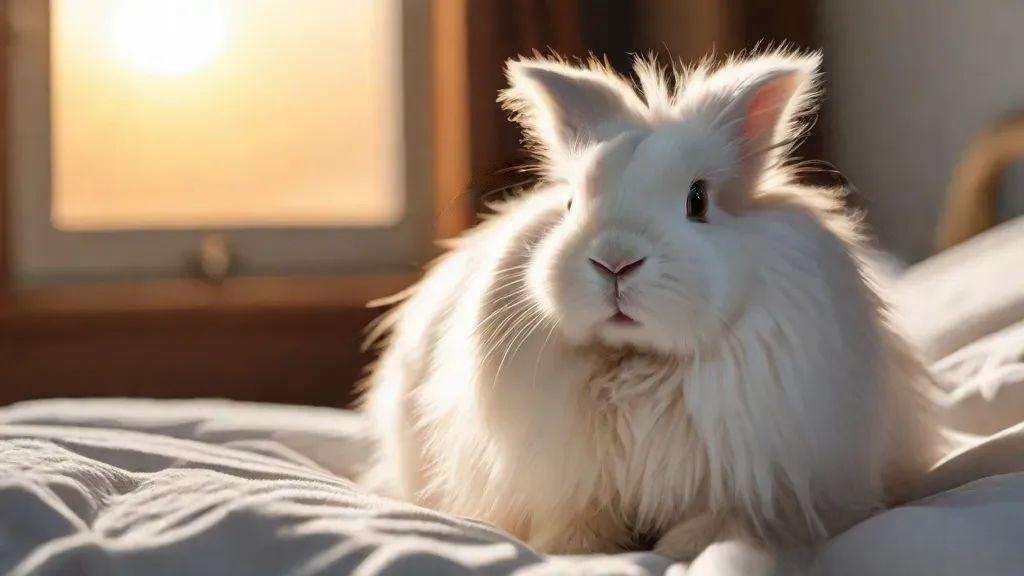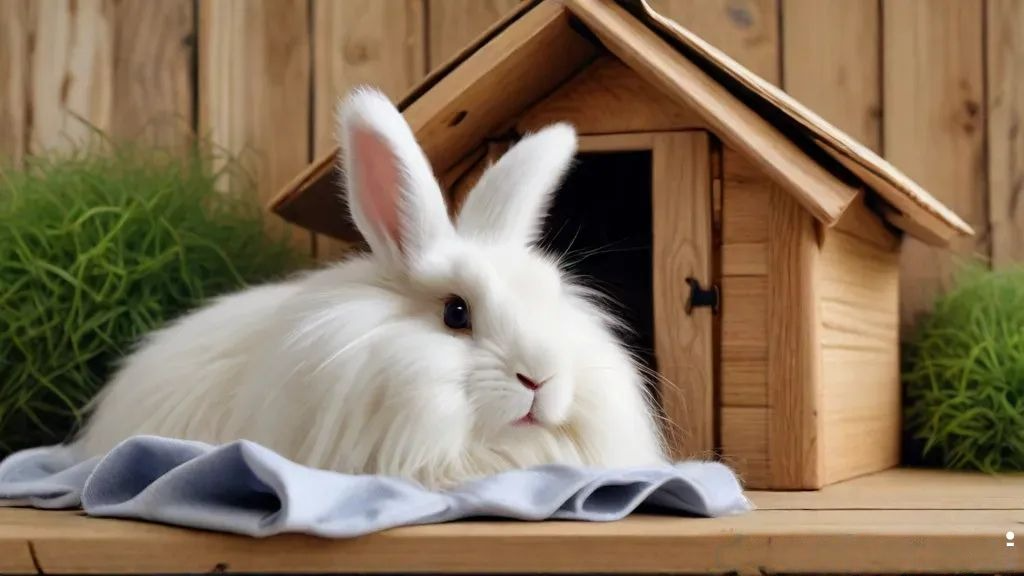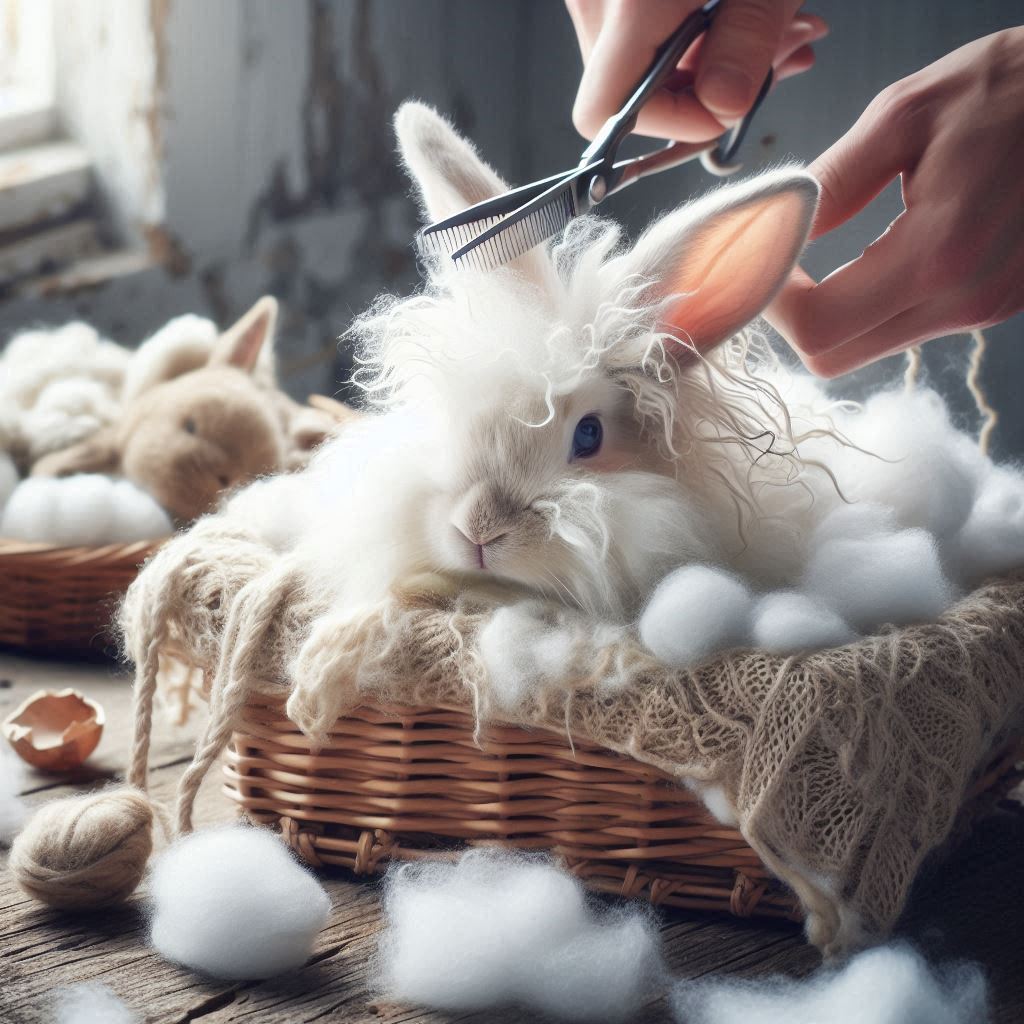What Makes the English Angora Rabbit Unique?
The English Angora Rabbit is special for its incredibly soft wool, which can be spun into yarn for crafts! These rabbits have been loved for centuries, not only because they are adorable but also because their wool can be used just like sheep’s wool. Unlike many other rabbit breeds, English Angoras require regular grooming to prevent their fur from tangling. They also have a calm, easygoing temperament, making them great pets for kids and families.

How Big Do English Angora Rabbits Grow?
On average, an English Angora Rabbit weighs up to 3kg when fully grown. While they are a bit bigger than some other rabbit breeds, they are not as heavy as other Angora breeds. Remember that your bunny’s size can vary based on the size of its parents, so it’s always a good idea to ask about their weight when adopting a baby Angora.
Personality and Behavior
English Angora Rabbits are known for their friendly, sociable, and loving nature. They enjoy spending time with humans and can also get along well with other rabbits or household pets like cats or dogs. What makes them extra special is how laid-back and calm they are. Both male and female Angoras are equally affectionate and love being handled, which makes them perfect for young pet owners.
Housing Needs for English Angora Rabbits
Providing a comfortable and spacious living area for your English Angora Rabbit is crucial for their happiness and well-being. These rabbits are highly active and love to hop around, so their housing needs to offer plenty of room for exercise. Whether indoors or outdoors, the space should be safe, clean, and equipped with mental stimulation toys to keep them entertained.
- Indoor Housing: Many owners prefer keeping their Angoras indoors because it helps them bond closely with their human companions. Indoor rabbits also tend to stay cleaner and are less likely to develop matted fur due to debris from the outside.
- Outdoor Housing: If you choose to house your bunny outside, ensure they have access to a large, secure hutch that protects them from predators and extreme weather conditions. Additionally, your bunny will benefit from supervised time to hop around in a fenced area.
Whether your English Angora Rabbit is housed indoors or outdoors, always provide them with bedding that doesn’t stick to their wool. Natural wood pellets or blankets are a great option. Avoid wood shavings, which can get caught in their long fur and cause discomfort. For information visit Can Angora Rabbits Live Outside?

Sex Differences
Unlike some other rabbit breeds, there are minimal differences in the personalities of male and female English Angora Rabbits. Both sexes are generally very sociable, affectionate, and friendly, seeking out human attention. This is particularly true when they are well-socialized from a young age.
The temperament of your rabbit largely depends on how often they are handled and the care they receive rather than their gender. Regular interaction and gentle handling will ensure your bunny remains calm and affectionate as they grow. Neutering or spaying your rabbit is highly recommended, as it can prevent behavioral issues and health problems in both males and females.
How to Groom an English Angora Rabbit
Grooming an English Angora Rabbit is an essential part of caring for these fluffy bunnies. Their wool grows continuously, so regular grooming helps to keep them comfortable and healthy. A well-maintained grooming routine not only prevents matting but also keeps their fur in top condition for crafting, spinning, or simply admiring. While grooming can initially seem daunting, it becomes easier with the right tools and techniques. Let’s explain how you can keep your Angora’s coat looking beautiful.
The Right Tools for Grooming
Before starting, it’s important to gather all the necessary tools for grooming. Here’s what you’ll need:
- Paddle Brush: Perfect for daily brushing to keep the wool tangle-free.
- Steel Comb with Rotating Teeth: Helps gently untangle knots without pulling out too much fur.
- Sharp Scissors: Use for trimming mats or wool during shearing sessions.
- Electric Clippers: Ideal for shearing thick mats or doing a full wool trim every few months.
- Nail Clippers: Regular nail trims are essential for Angoras that roam outside.
Having all your tools ready before you begin will help keep the grooming process smooth and stress-free for both you and your rabbit. It’s also a good idea to use a small table to elevate your rabbit during grooming, making it easier to handle and reducing the chances of your bunny hopping away mid-session.
Daily and Weekly Grooming Routine
To keep your English Angora Rabbit‘s fur free from mats, you’ll need to brush them at least every 2-3 days. Here’s how to do it:
- Start by Brushing the Outer Layer: Use the paddle brush to remove any surface-level tangles. Always brush in the direction of the fur growth to avoid discomfort.
- Work in Sections: Separate the wool into small sections to ensure you cover all areas. This helps prevent matting, especially in hidden spots like under the chin or belly.
- Check for Mats: Use the comb with rotating teeth to gently work out any knots or tangles. Mats can form quickly, especially in the neck, armpits, and groin area, so pay extra attention to these spots.
- Blow Air Through the Wool: Try blowing air gently into the fur before you start brushing to remove debris like hay or dust. This technique helps clean the wool and makes brushing easier.
The secret to effective grooming is maintaining a gentle touch and plenty of patience. Angoras have sensitive skin, especially in areas like the neck and belly, so take your time to avoid accidentally pulling or cutting their skin.

Shearing Your English Angora Rabbit
Every 3-4 months, your English Angora Rabbit will need a full shearing. Shearing helps manage the length of their wool and keeps them cool, especially in warmer months. Here’s a step-by-step guide:
- Prepare Your Station: Set up all your tools and ensure your rabbit is comfortable. It’s best to shear in a quiet space with no distractions. Using a grooming table helps, as it prevents the rabbit from wandering off.
- Trim Slowly: Start with the back and sides of the rabbit, using sharp scissors to trim the wool close to the skin without cutting it. Always hold the scissors at an angle and locate the skin before each snip.
- Use Electric Clippers for Mats: Electric clippers can be a lifesaver if your bunny has thick mats, especially under the chin or belly. Move slowly to avoid any skin nicks. Never clip too close to the skin, especially in cold weather, as this can affect your rabbit’s ability to regulate its temperature.
- Focus on Hot Spots: Areas like under the chin and behind the ears tend to develop mats more quickly. Gently hold the bunny and work on these areas carefully, checking them every time you groom.
Tips for Beginners
If you’re new to grooming English Angora Rabbits, here are a few tips to make the process easier:
- Don’t Rush: The first few grooming sessions may take longer, but with practice, you’ll become quicker and more confident.
- Work in Sections: Divide the fur into smaller sections and work through each part systematically. This reduces the chances of missing spots or causing discomfort.
- Stay Calm: If your bunny starts to squirm, take a break. Keeping your rabbit calm will make the process much smoother.
- You Can Always Start Again: If things don’t go as planned, remember that the wool will grow back quickly. Making mistakes is perfectly fine, especially when you’re still learning.
How to Harvest Wool for Crafts
If you plan to use your English Angora’s wool for spinning or selling, keeping it clean and free from mats is crucial. Regular grooming will ensure the wool is smooth and sleek, making it easier to card and spin for felting or knitting projects. After each grooming session, gently remove the brushed-out wool and store it in a clean, dry place. When shearing, avoid cutting too close to the skin to maintain the quality of the wool.
Wool Uses
One of the most exciting aspects of owning an English Angora Rabbit is the ability to collect and use their wool. The wool from these rabbits is highly prized in the crafting world due to its softness and warmth.
- Spinning: You can spin the wool into yarn for knitting or crocheting. It’s lightweight, warm, and perfect for making scarves, hats, and other garments.
- Felting: Angora wool can also be used for felting projects, which is a great way to create artistic crafts like wool sculptures, ornaments, or needlework.
- Selling Wool: If you don’t want to use the wool yourself, you can sell it to crafters. English Angora wool is often in demand for its high quality and versatility.
Keeping the wool free from mats and debris through regular grooming will ensure it remains in excellent condition for crafting or selling.
Grooming Challenges and Solutions
Here’s a table for Grooming Challenges and Solutions:
| Grooming Challenge |
Solution |
| Matted Wool |
Use a steel comb or electric clippers to gently trim the mats without touching the skin. |
| Sensitive Areas (Neck, Groin) |
Take extra care in these areas, trim slowly with sharp scissors, and ensure the skin is visible before cutting. |
| Excess Debris in Wool |
Blow air through the fur before brushing to remove loose debris like hay or dust. |
| Squirming During Grooming |
Groom in a calm, quiet space, and consider placing your rabbit on a raised table to limit movement. |
| Wool Sticking to Brushes |
Use a comb with rotating teeth to prevent wool from getting caught and pulled during grooming. |
| Overgrown Wool in Summer |
Regular shearing every 3 months helps to keep the wool manageable and prevents overheating. |
| Nervousness When Grooming |
Start with short grooming sessions and gradually increase the time as both you and your rabbit become more comfortable. |
| Missed Areas During Grooming |
Work in small sections, methodically moving from one body part to another to ensure all areas are groomed. |

How to Ensure Your Rabbit Stays Healthy and Happy
Like any pet, English Angora Rabbits need proper care and space to be happy. Here’s how to create the best environment for them:
- Housing: Provide a large, clean area for your rabbit to move around. Whether your Angora lives indoors or outdoors, ensure they have plenty of room to hop, explore, and play.
- Diet: Feed them fresh greens, hay, and clean water daily. This keeps their fur and overall health in top condition.
- Exercise: Rabbits need time outside their cage to hop around and stay active, so let them roam safely for a few hours daily.
Vegetables for Angora Rabbits
Fruits for Angora Rabbits
Single or Multiple Rabbits?
While it might seem like a good idea to adopt two bunnies, especially if they live outside, taking care of two English Angora Rabbits can be challenging, starting with one is usually better for new bunny owners, especially since grooming takes a lot of time. If your bunny is an indoor pet and you spend lots of time with them, they’ll form a strong bond with you, just like a dog or cat.
Fun Facts About English Angora Rabbits
- Did you know that their wool can grow up to 6 inches long? That’s almost as long as a pencil!
- English Angoras are so calm that they don’t mind being groomed. They appear to enjoy the extra attention!
- They live for about 7-10 years, making them long-term companions for families.
- You can use their wool for felting, knitting, or even selling it to other crafters.
Final Thoughts
The English Angora Rabbit is an incredible pet that brings joy and warmth to any home. With their gentle personality and soft wool, they’re loved by both children and adults alike. While they require extra care, especially regarding grooming, the effort is worth it. If you’re considering adopting an English Angora, be ready for a fun, rewarding experience!
Remember, if you ever feel unsure about grooming or care, plenty of online resources and communities help you. Enjoy your fluffy new friend!
FAQs
- Are English Angora rabbits good pets?
Yes, English Angora rabbits make excellent pets due to their calm, friendly nature and their love for human interaction, especially with regular grooming.
- How much do English Angora rabbits cost?
English Angora rabbits typically cost between $50 to $250, depending on factors like breeder reputation, age, and whether they come with pedigree papers.
- How big do English Angora rabbits get?
English Angora rabbits usually weigh between 2.5 to 3.5 kg (5.5 to 7.7 lbs) when fully grown.
- How long do English Angora rabbits live?
English Angora rabbits have an average lifespan of 7 to 10 years, with proper care potentially extending their life beyond 10 years.
Further Reading






Leave a Reply